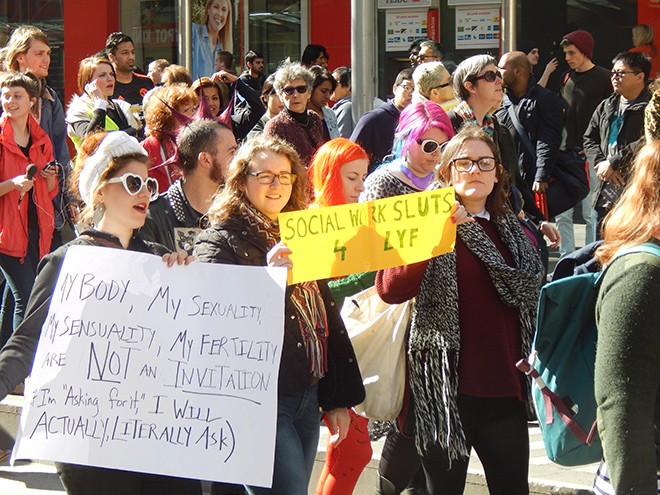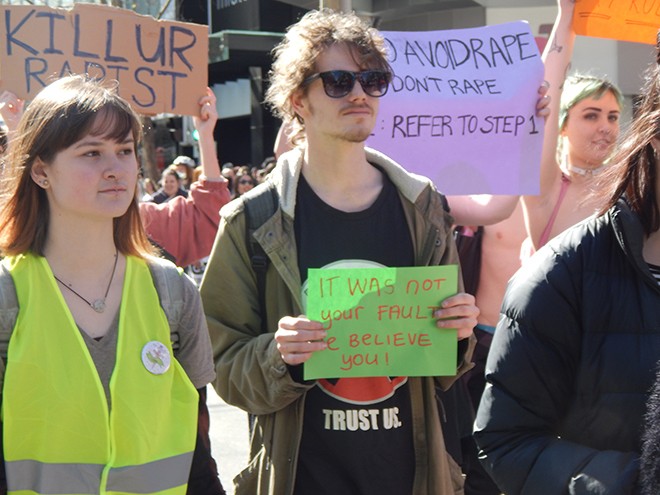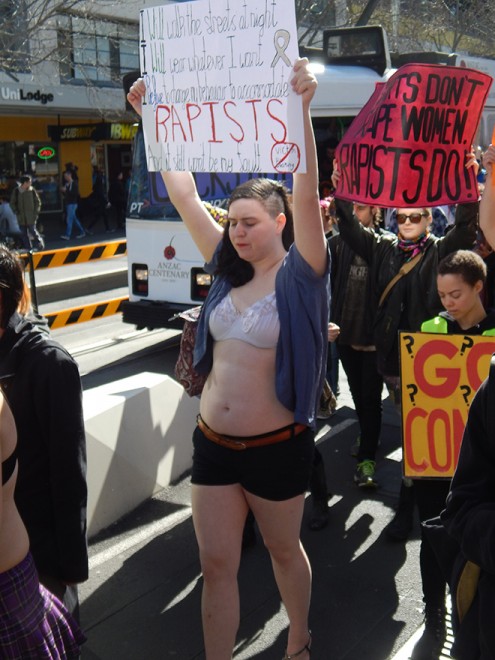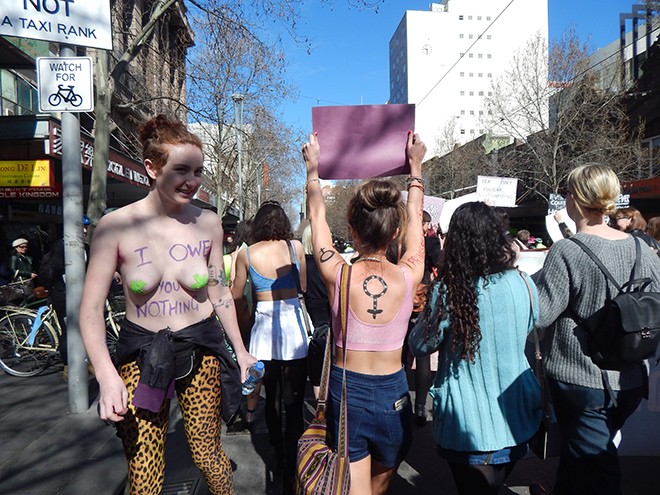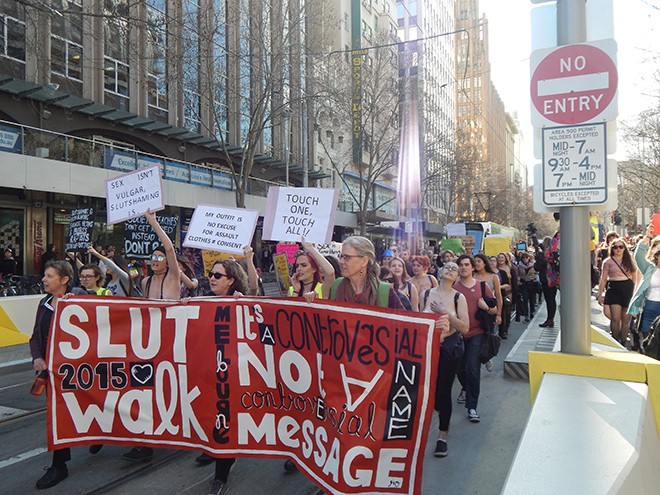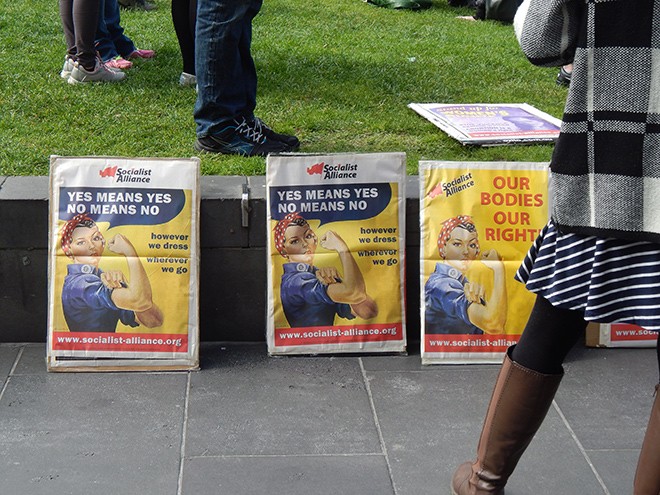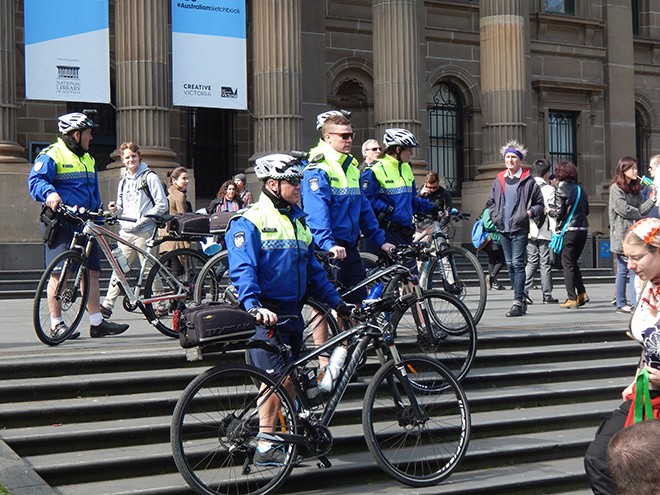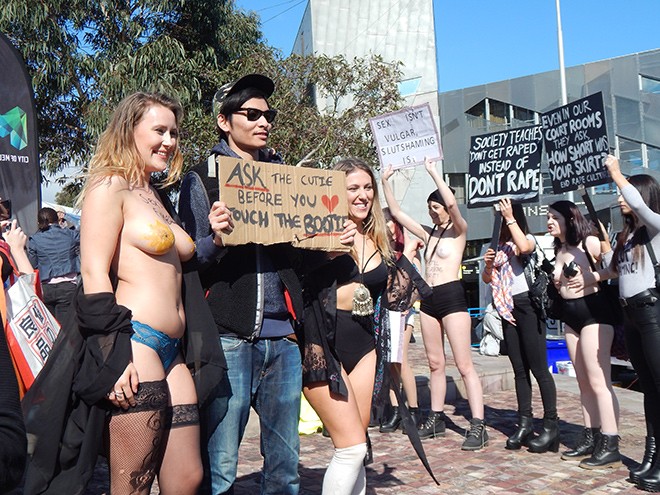Defiance, Feminism, Empathy: The Endurance And Evolution Of Slutwalk In Australia
We brought our cameras and our questions to this weekend's March in Melbourne, to find out about the changing face of the movement.

This post discusses sexual assault.
–
As far as protest goals go, ending slut shaming, sexual violence and rape culture is pretty damn huge. This isn’t an Australian Border Force operation; it was never going to be toppled in three hours. But going against something so vast, insidious and deeply rooted in ideology, it’s hard to know exactly how much progress has been made since the world’s first Slutwalk in 2011.
What we can see is that the numbers of Australian protesters have slightly dropped. Though chapters remain all over the country, the thousands which turned out in the first Australian Slutwalk protests seem to have dropped dramatically, and some cities remain far more active than others. The number of news reports have dwindled accordingly. After receiving blanket coverage in its inaugural 2011 march, discussion of last weekend’s Melbourne event — the nation’s largest offering this year — was localised to smaller, independent publications, and the journalists on the ground seemed to be exclusively from either universities or community organisations.
And yet, there were still hundreds who marched enthusiastically through the CBD, chanting and holding protest signs through linked arms, with a promise that they’d all be back once again next year.
Is the Slutwalk movement still in service of the same important yet unwieldy goal, or has the purpose slightly changed along the way?
–
The Road To Change Is Much Longer Than Swanston Street
The world’s first Slutwalk in Toronto, Canada was intended as a response to comments made by a local police constable. Speaking about a sexual assault that had taken place at one of the city’s universities, a young male officer chimed in at a press conference to state, “Women should avoid dressing like sluts in order not to be victimised”.
Though he soon apologised after much public outcry, the damage was done. Many women were frustrated by the familiar tendency for both law enforcers and the media to shift implicit or overt blame onto the victims of violent crimes, and were mobilising to make a stand against it. Thousands marched to the police station demanding respect for victims and sovereignty for women’s sexuality and bodies, and a couple of months after it caught on in Europe, the USA, South America, Asia, and Australia.
In the years since, there’s arguably been a shift towards sex positivity in Western culture at large, or more specifically Western pop culture. Terms like “slut-shaming” and “victim blaming” have entered the common vernacular; prominent women like Nicki Minaj and Amber Rose are celebrated for publicly calling out discrimination when it comes their way; and others both at home and abroad have started to skewer serious issues such as rape culture in mainstream comedy. But while these certainly signify a wider acceptance of more progressive attitudes, that doesn’t always translate to concrete change.
In 2013, we heard radio shock jock John Laws joke about sexual violence and ask a victim of incest whether she had felt responsible for her assault. In 2014, the Courier Mail made entertainment of the murder of a trans sex worker by calling her a “she-male” on their front page. Victims of sexual violence are still routinely subjected to triggering and inappropriate responses from the media, and it’s clear we haven’t yet learned to turn the blame solely on those responsible. The days after Jill Meagher’s murder, for instance, were filled with speculation about the fact she had been out drinking, and walked the short distance home alone. This judgement was expressed even more overtly earlier this year. After the murder of 17-year-old Masa Vukotic in a Melbourne park, a local homicide inspector suggested women “shouldn’t be alone in parks” at all.
These stories aren’t even remarkable. One recent study showed an enormous 84 percent of young Australian women are still routinely harassed on the street, and 93 percent have felt the need to change their behaviour to ensure their safety. Despite increasing awareness and campaigns against it, figures still suggest that one in three women will experience physical abuse and one in five will be sexually assaulted.
It’s unreasonable to think that Slutwalk could stop this, but what it can do is give these people both a voice and a community.
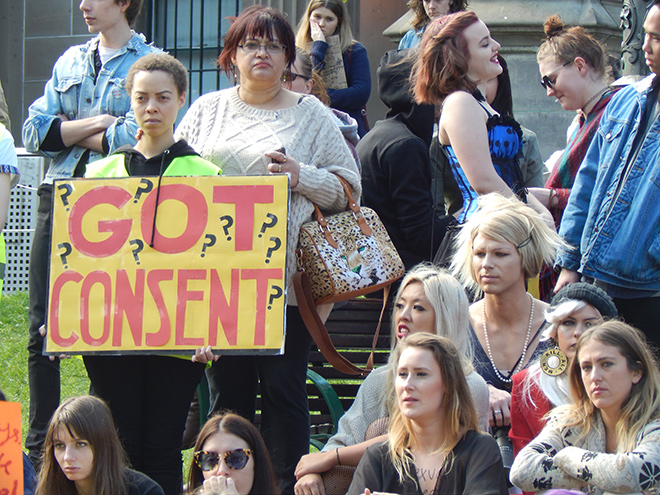
–
“Start A Conversation, Create A Movement, Be The Change”
On Saturday afternoon as people gathered on the steps of the State Library –and some removed their shirts to reveal paint and nipple tassels — an advocate from a NSW women’s refuge Nabila Farhat addressed the crowd atop a makeshift stage. Here, she talked about the strict arbitrary guidelines she faced growing up in a conservative household as well as the experiences of her friends — young women who were made vulnerable or exploited and had never been able to get their story across.
“At 22, my mum found contraceptive pills in my room and demanded that I stop taking them, even though they were being used to control my hormonal acne,” she said. “At 24, I was called a pr*stitute because I refused to have an arranged marriage. And now, at the ripe old age of 26, I find myself constantly having to look over my shoulder when I walk to my car late at night because, as a woman, I don’t feel safe.”
“While it may not seem like it on the surface, each of these incidents — or for a better world, micro-aggressions — contribute to an endemic of rape culture. It also sadly highlights the fact that every society has a long way to go in changing the beliefs that we hold towards sexual violence and women. We have a long way to go, but this is where it starts. Start a conversation, create a movement, be the change.”
Notably, the conversations taking place on the day were impressively broad. Alongside Farhat was writer Van Badham (who fearlessly asserted she was a survivor or sexual assault), sex worker Jane Green from the Scarlet Alliance and Vixen Collective (who made a point of speaking about the time she spent homeless and how being part of disadvantaged communities made it even more difficult to seek justice for her rape), and two members of the trans community named Luca and MJ. As organiser Jessamy Gleeson told Spook beforehand, inclusivity and diversity were big goals of this year’s protest.
Green, for instance, spoke about the struggles sex workers face in being granted both equal access to legal justice, and legitimacy in the eyes of the Australian public.
“To us, this fight is eternally visible,” she said. “It is the fabric of our lives and work. But to those that are not part of our community, it is often hidden. I believe this is what makes people turn away from our struggles rather than embracing us as allies … [Some] call us ‘product’, not people. They say sex workers sell their bodies, but my body is still here. I sell a service.”
Speaking from experience as both a trans activist and teacher, Luca shared a different yet equally as compelling testimony about trans people in the education system. After recalling a story about teachers complaining about the change in pronouns for a student who had recently come out as trans, the following stats were dropped:
“Between the ages of 18-24, 40 percent of trans/non-gender conforming youth will attempt suicide,” Luca said. “30 percent of students who come out as trans between the ages of 15-17 will not complete secondary schooling. This is due to a number of factors which largely include bullying and a lack of a supportive environment.”
There’s a good chance you’ve heard that before; a study from Beyond Blue last year had similar figures suggesting that while 37 percent of trans youth will attempt suicide, an enormous 81 percent will think about it and 70 percent had self harmed. As Luca spoke people silently embraced on either side of the small stage. A group of trans women who had all been chatting and making friendly introductions stood still in silence.

–
The Strength And Community In Protest
I say this as neither a socialist or a criminal, but there’s something really empowering about being part of a mob. Whether it’s advocating for marriage equality or the protection of higher education, there’s an inherent safety and camaraderie that comes with being among likeminded people, making a stand for change. And, having been deep in the Slutwalk rabble as it spilled down Swanston Street, I think this may be one of the protest’s most valuable aspects.
Before the day itself, women post on both the Facebook page and event page introducing themselves and getting excited. One trans woman says she’s just moved interstate and would love to make new friends. When I arrive, groups are flowing to and fro, filled with cheerful introductions and compliments about people’s outfits. The regulars give the newbies tips on sign-making and help pen messages with permanent markers on their arms and backs. Some read “still not asking for it”; others simple state “RAPE SURVIVOR”. It’s the kind of place where eye contact will lead to a smile or conversation rather than an awkward turn away.
In fact, this is the whole point. “This is a space that loves you for who you are,” Van Badham announces, with deliberate emphasis on each word. “This is a space where you are safe. This is a space where you can be proud. This is a space where your survival means something to everyone.”
As if to emphasise this, a number of speakers take the time to celebrate the legacy of writer and fellow Slutwalk collective member Kat Muscat. After organising past marches, and doing an enormous amount of fiercely feminist work while dealing with ongoing mental health problems, Kat took her own life earlier this year.
“Kat Muscat had a tattoo that sums up everything about today,” Badham says. “Three words: defiance, feminism, empathy.” She asks the crowd to chant it. She asks them to do it twice. She asks for a third time “so the whole city can hear it”. A woman next to me is screaming, and the message continues as the march begins.
The crowd are throwing the words at Melbourne Central, at Chinatown, at Melbourne Town Hall, and finally at Flinders Street Station amidst a number of other chants on the 15-minute stretch. “‘Yes’ means yes, ‘no’ means no.” “We shouldn’t have to, be afraid at night.” “Defiance. Feminism. Empathy.” Many onlookers have their phones out filming or taking pictures. Most are smiling. Some are clapping. One woman jeers. She gets within a metre of someone with “Rape survivor” penned on their skin and boos, with both thumbs down in front of their face.
When we get to Fed Square, the protest is over but everyone sticks around to exchange stories or numbers and pose for photos. A few are giving student journos familiar quotes about slut shaming and rape culture, but many seem reluctant. Though they’re happy to chat casually, some tell me they just came along for the experience, or to meet new people, or to get one simple message across. It’s all on their signs.
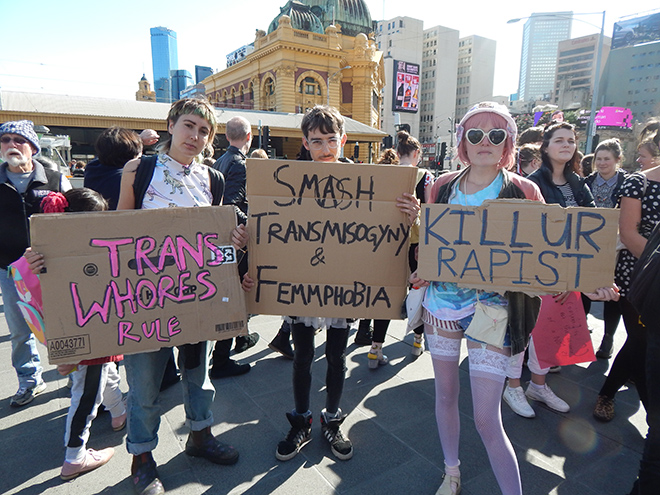
Around the fringes of the group, three teenage boys gawk excitedly at the fishnets and bustiers, and some creepy lone men take photos. When confronted about it, a jolly older man says he just wants to get the message out and he’s left to it; another has no answer at all and is chased away by protesters jokingly snapping photos of him.
At one point, a stocky middle-aged man in a Hawthorn guernsey approaches a young Swedish woman who’s topless aside from some gold paint on her nipples. And, though I watch on half-expecting to interject or help escort the creep away, the conversation looks pleasant. She tells me he just wanted to know what was going on, and when I see him leave he kneels down to three young boys who might be his grandchildren. He points around at the various groups and makes explanatory hand gestures before whisking them away to the afternoon match at the MCG.
At the end of all this, it’s hard to say how effective it’s been in challenging cultural stigmas or fighting rape culture at large. It may be that those aren’t even the right metrics to gauge its success. With the steadfast acknowledgement that the problem will remain, the organisers immediately pledge to be back the following year. Women put their shirts back on and disperse on trams that are starting to fill with crowds for the football — large men in scarfs and caps whose grandfathers might not have taught them well; men who will later spend the night drinking in the city.
At the very least, it was nice to feel like those streets were our own for awhile.
–
See more photos from Slutwalk Melbourne here:
